Plextor M6e Review: Solid State Drive for PCI Express

We all look forward to SATA Express and M.2 interfaces expansion and appearance SSDs for these interfaces. However, we can buy a SSD for PCIe bus, Plextor have gave us such an opportunity already. Is it a good choice or we should wait of introducing of other drives with SATA Express and M.2 interfaces?
Last year we could witness how easily major corporations could oust smaller players from a market. You can see such examples everywhere as soon as an industry shows some growth and promises good profits, but we’re talking specifically about solid state drives. It is in 2013 that the semiconductor giants that manufacture flash memory got interested in the consumer SSD market. We mean Samsung and Micron in the first place. Pursuing a very aggressive strategy, these two companies significantly increased their market share thanks to users switching to SSDs and to other companies reducing their SSD shipments. Having inexpensive flash memory of their own making at their disposal, Micron and Samsung have released attractive products that are generally cheaper than competing offers but ensure good performance.
It is hard to beat such major players who can get flash memory at its production cost and invest heavily into research & development. There are only three companies, namely Intel, Toshiba and SanDisk, that manufacture their own flash memory and might compete with Samsung and Micron in terms of pricing. The rest of SSD makers have to rely on their engineering potential and attract the customer with niche solutions. So we shouldn’t be surprised that there is a trend for SSDs to be available in fewer models. This background makes nonstandard solutions from second-tier manufacturers stand out even more conspicuously, though. One of the most illustrious examples is Plextor which used to be considered one of the main suppliers of consumer-class SSDs just recently.
Plextor’s older M5S and M5P solutions, which had used to be among the best SSDs for desktop PCs, got outdated eventually, so the company had to update its model range. Plextor needed a product with unique features and it has released the M6e, an SSD with native PCI Express interface.
As a matter of fact, consumer-class SSDs with PCI Express interface are about to get mainstream in the near future. The modern trend is for PCI Express to replace SATA 6 Gbit/s everywhere. It is even written in the latest SATA 3.2 specification. SSDs have become so fast that they are almost limited by the SATA 6 Gbit/s bandwidth, calling for a replacement to that interface. It is impossible to speed SATA up in an easy way without redesigning its connectors and cables and making its controllers more expensive, so the entire industry is now set to transition all SSDs to the faster and more versatile PCI Express bus.
Thus, the Plextor M6e is a kind of a first experiment on implementing a new bus in consumer-class SSDs. It is going to be followed by lots of other similar products. Plextor has decided to transition to the new bus prior to modern PCs acquiring the necessary infrastructure in the form of new-generation SSD ports and slots. Instead, the manufacturer has implemented its flash drive as a regular PCIe card. We’ll check out the result in this review.
M.2 and Serial Express: SSD Design for PCI Express
To be the first manufacturer to transfer its consumer-class SSDs to PCI Express, Plextor came up with a small ruse. Instead of waiting for PCs to acquire new-generation PCI Express based slots and connectors (M.2 and SATA Express) described in the SATA 3.2 specification, the company implemented its SSD as a regular PCI Express card. That’s not optimal from the specification’s point of view. Why? Well, the whole infrastructure is oriented at SSDs implemented either in 2.5-inch cases or as compact expansion cards. The regular PCIe card format is not considered optimal for an SSD because computers may lack additional PCIe slots, especially if you want to install several such SSDs into a single desktop PC.
According to the SATA roadmap, desktop SSDs will be designed just like earlier but will use a special interface, called SATA Express, with new connectors and cables. A SATA Express interface combines two SATA 6 Gbit/s interfaces (for backward compatibility with older drives) and several PCI Express lanes. First-generation SATA Express ports, which may be currently available on mainboards with Intel’s Z97 chipset, use two PCI Express 2.0 lanes, providing a peak bandwidth of 1 GB/s.
The second PCI Express connection option described in the specification is the specialized M.2 slot (also known as NGFF). It is oriented at mobile applications in the first place. Combining one SATA 6 Gbit/s and several PCI Express lanes, such slots are rather small and thus perfect for slim notebooks. The first implementation which is currently used on mainboards with Intel’s 9 series chipsets uses two PCI Express 2.0 lanes. Thus, the M.2 slot can be viewed as a mobile version of the SATA Express interface.
Today’s M.2 and SATA Express implementations are far from the perfection described in the SATA 3.2 specification. Their data-transfer rates might be increased considerably by using more than two PCI Express lanes. As for SSD makers, they are theoretically prepared to launch products that might make full use of even four PCI Express lanes but Intel deliberately limited the speed of the M.2 and SATA Express implementations in its Z97 and H97 chipsets to the PCI Express 2.0 x2 variant whose bandwidth is no higher than 1 GB/s.
Besides introducing the faster physical bus, the SATA 3.2 specification brings about one more important innovation. It is the new logical protocol NVMe that is supposed to replace the outdated AHCI. Designed for hard disk drives, the AHCI protocol doesn’t support parallel processing of data access requests whereas the new NVMe is optimized for PCI Express and nonvolatile memory. As opposed to AHCI, it takes into account such SSD features as low latency and parallel architecture. It is also optimized for today’s multithreaded computing platforms. That’s why NVMe supports multiple request queues of nearly unlimited depth, new interrupt processing methods and other techniques which significantly increase the efficiency of the physical bus with SSDs.
As you can see, there are a lot of options for a manufacturer to build a cutting-edge SSD with PCI Express interface. The drive can be designed as a regular PCI Express card, an M.2 card or a SATA Express module. On the logical level, it can use either the conventional AHCI or the newest NVMe protocol. Each variant has its highs and lows but Plextor went for maximum compatibility with currently available computers.
Plextor M6e: Design and Features
Formally, M.2 slots and SATA Express ports are currently supported by Intel’s Z97 and H97 chipsets only. These chipsets have two high-speed data-transfer channels that can work as two SATA ports or two PCI Express 2.0 lanes. Multiplexed into a single interface, they can be used to implemented one SATA Express port or one M.2 slot. Implementing M.2 or SATA Express with other chipsets is possible but takes too much hardware resources, therefore you can find but a few older mainboards with such interfaces. In other words, M.2 slots and SATA Express ports are still rather rare.
The same goes for the NVMe protocol. It doesn’t enjoy widespread software support currently. While AHCI is supported by every popular OS, a native NVMe driver is only available in Windows 8.1 and Windows Server 2012 R2. The majority of UEFI BIOS implementations do not support NVMe as well, making it impossible to use NVMe drives for booting up. Cutting it short, desktop PCs are not yet well prepared to transition to NVMe.
Considering that, Plextor didn’t have to think long about what protocol to implement in its PCIe SSD product. To minimize potential incompatibilities, it is designed as a regular PCIe card and uses the AHCI protocol. Although not a very handy and progressive solution, it is guaranteed to work in nearly any computer that has at least one PCIe expansion slot.
Well, the actual product is rather more complex than that. Plextor unified its M6e with a similar PCIe drive designed for an M.2 slot. So the desktop M6e drive is an M.2 card (80×22 mm) mounted on a PCIe -> M.2 adapter. Thus, Plextor offers the M6e in two versions, for PCI Express and M.2 slots, which are in fact one and the same drive.
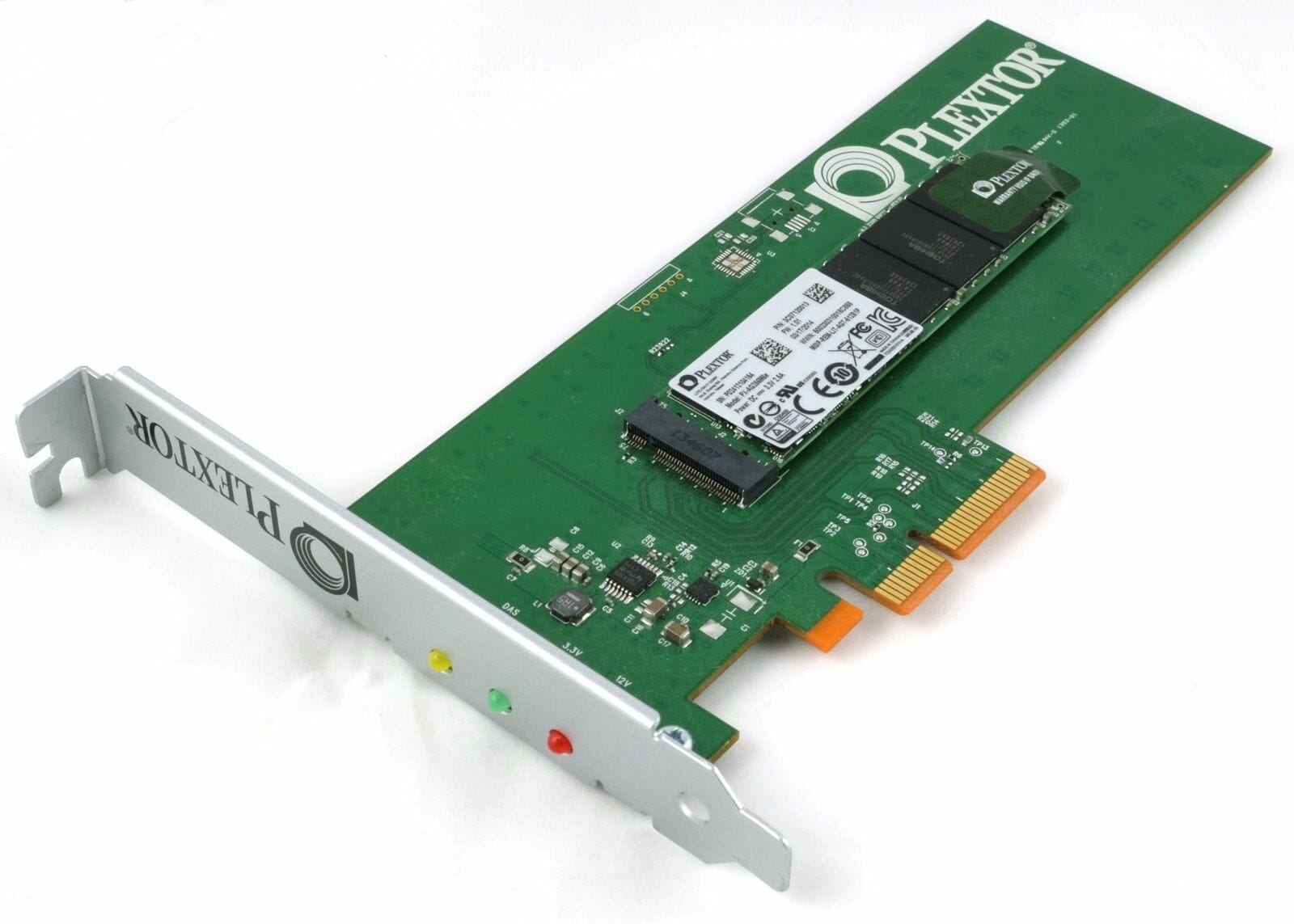
The core of the M6e is an M.2 SSD designed for PCI Express 2.0 x2. That’s the speed that can be provided on M.2 slots by today’s mainboards with Intel’s 9 series chipsets. The desktop M6e combines that SSD with a PCIe x4 adapter. Considering that the “core” needs only two PCIe 2.0 lanes, the M6e card can be installed in a PCIe 2.0 x2 slot.
Despite the unconventional form-factor, the Plextor M6e’s AHCI support solves a lot of usability issues. It doesn’t need any special drivers. It will be recognized by any modern OS without any actions on the user’s part. All SSD-related algorithms in the operating system will be fully functional. Particularly, the TRIM command works perfectly with the M6e. There’s no problem about using it as a bootable disk. A mainboard’s UEFI will recognize this PCIe SSD and add it to the list of devices you can boot your OS from. Moreover, if you install the Plextor M6e into an M.2 slot on a Z97- or H97-based mainboard, it will be identified by the Intel Rapid Storage Technology driver (from version 13), allowing to use it for Intel Rapid Start. The only limitation is that you can’t build RAIDs with your M6e.
This broad compatibility is no achievement of Plextor’s, though. The M6e is basically an ordinary enough AHCI flash drive for an M.2 connector but bundled with an additional PCI Express adapter.
Plextor M6e 256GB in Detail
The Plextor M6e is the flagship model in the new M6 series. It is a special model, too. Plextor plans to release one more flagship, M6 Pro, which is a conventional SATA SSD in a 2.5-inch case. The M6e, on its part, is an experimental model oriented at enthusiasts (in its PCIe version) as well as mobile users (in the M.2 version).
Considering that the M6e’s core (in either version) is in fact a mobile SSD, its specs are far from exceptional. It is the PCIe 2.0 x2 bus alone that ensures its advantages over its predecessors. There are no improvements in terms of internal design. The Plextor M6e’s peak theoretical interface bandwidth is about 1 GB/s but for practical purposes it is an effective 770 MB/s at sequential operations. This is only 40% higher compared to SATA 6 Gbit/s drives.
Apart from the PCIe connection, the Plextor M6e is designed in a conventional way. It is based on a Marvell 88SS9183 controller which, on one hand, supports those two PCIe 2.0 lanes and, on the other hand, has a typical eight channels for accessing flash memory which is represented by 19nm MLC NAND chips from Toshiba. The same memory was installed in the Plextor M5 Pro, for example. The controller features Marvell’s exclusive design with two ARM cores and firmware from Lite-On which has a vast experience with Marvell products.
The desktop PCIe version of the Plextor M6e comes in a bright red box with lots of logotypes and icons of supported technologies. Product specs are listed on the packaging, too.
Besides the SSD card (assembled out of an M.2 drive and a PCIe adapter), the box contains a mounting screw, an installation guide, and a tech support notice.
The assembled Plextor M6e (in its out-of-box state) looks like this.Take note that the M.2 drive is not just fixed in the adapter with a screw but also covered with a warranty sticker, meaning that users are not permitted to dismantle the M6e and install the SSD into an M.2 slot without breaching the warranty conditions. Plextor offers the same SSD in an M.2 version for such purposes.
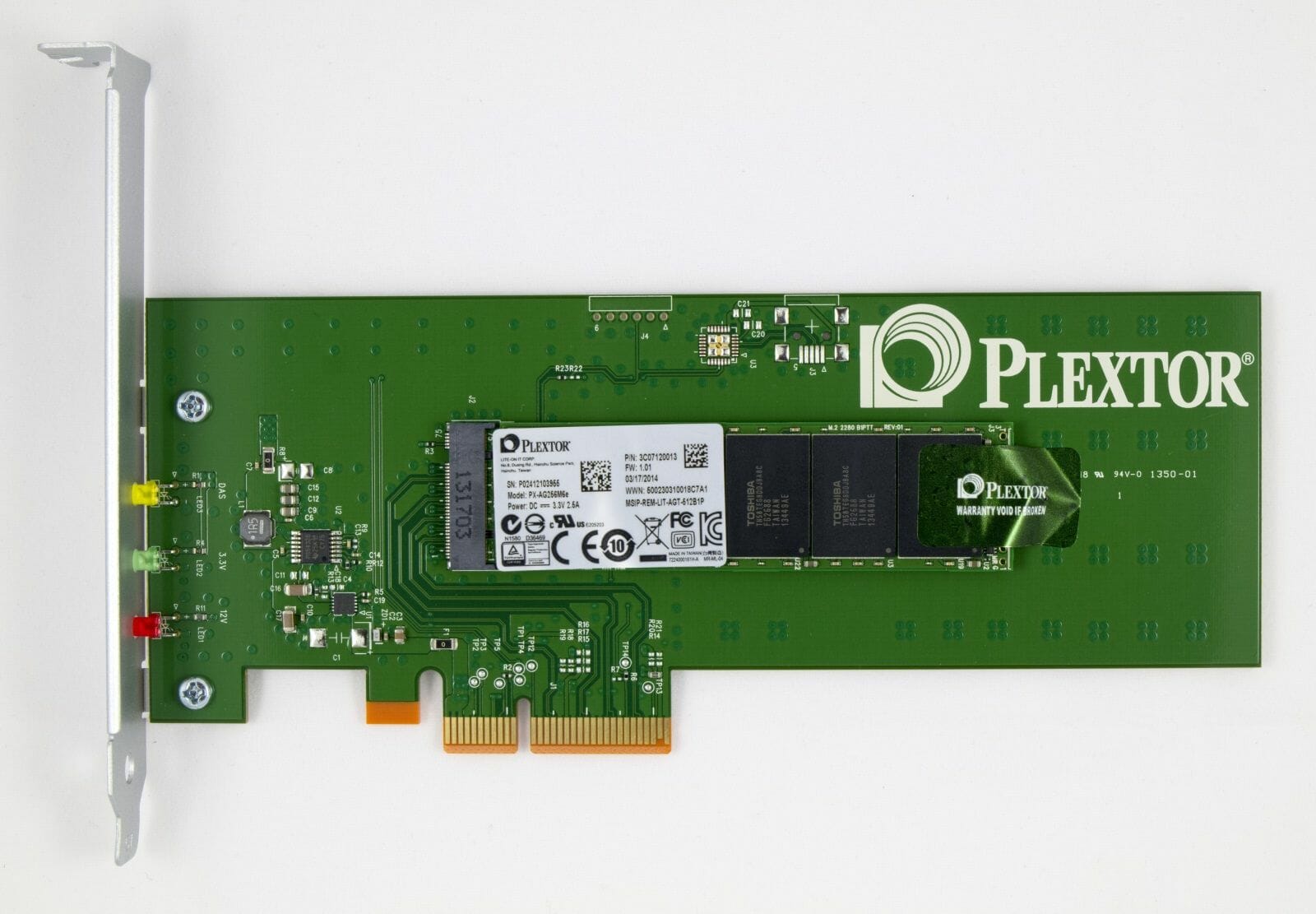
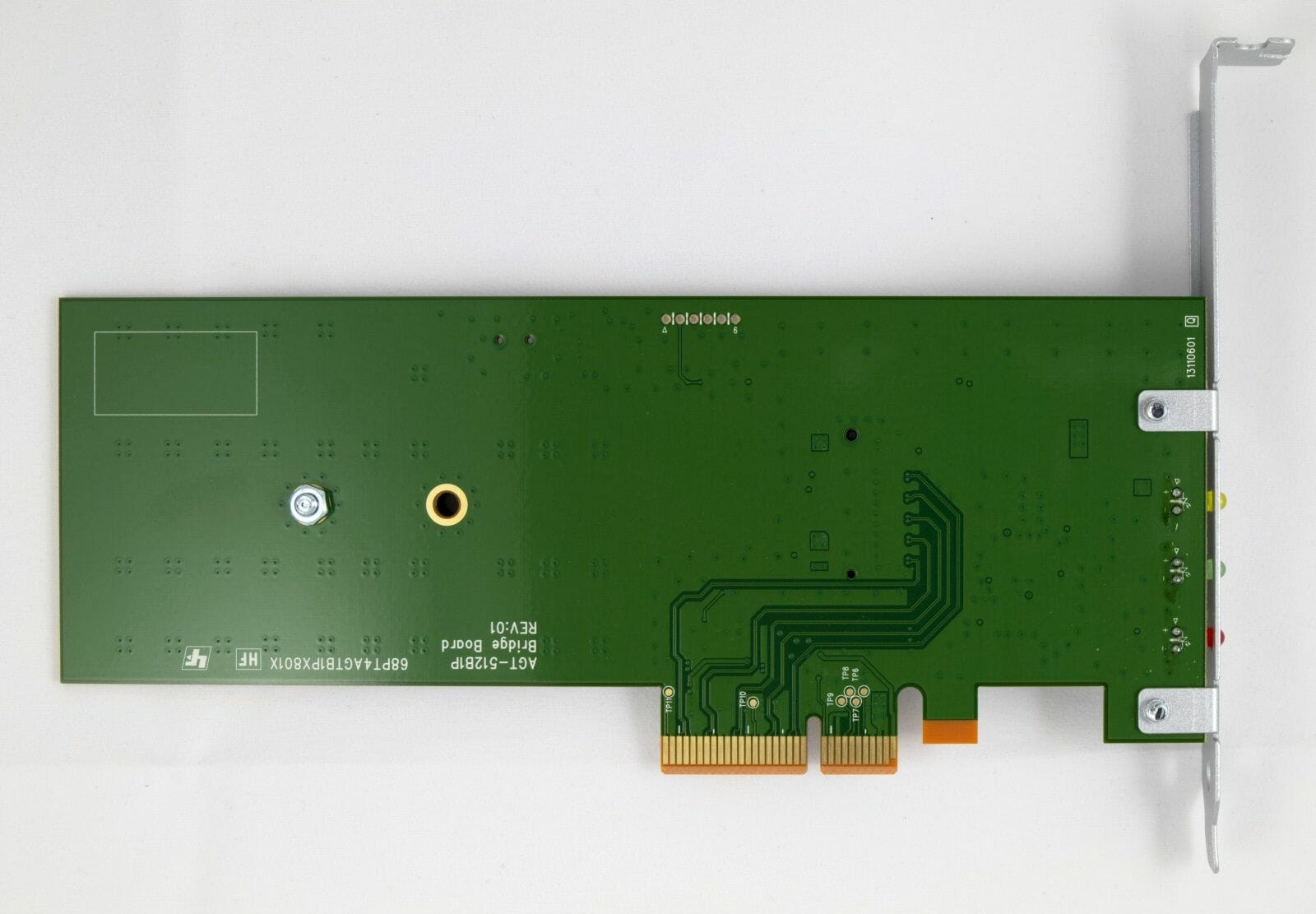
The M.2 part of the Plextor M6e is a small and densely populated card. There are four flash memory chips on both sides of it. Judging by the marking (TH58TEG8DDJBA8C), each contains four 64-gigabit MLC NAND dies manufactured by Toshiba on the first-generation 19nm tech process. Coupled with the Toggle Mode interface promoted by Toshiba together with Samsung, Hynix and SanDisk, this memory is widely used in modern SSDs. You can see it in many flagship models.
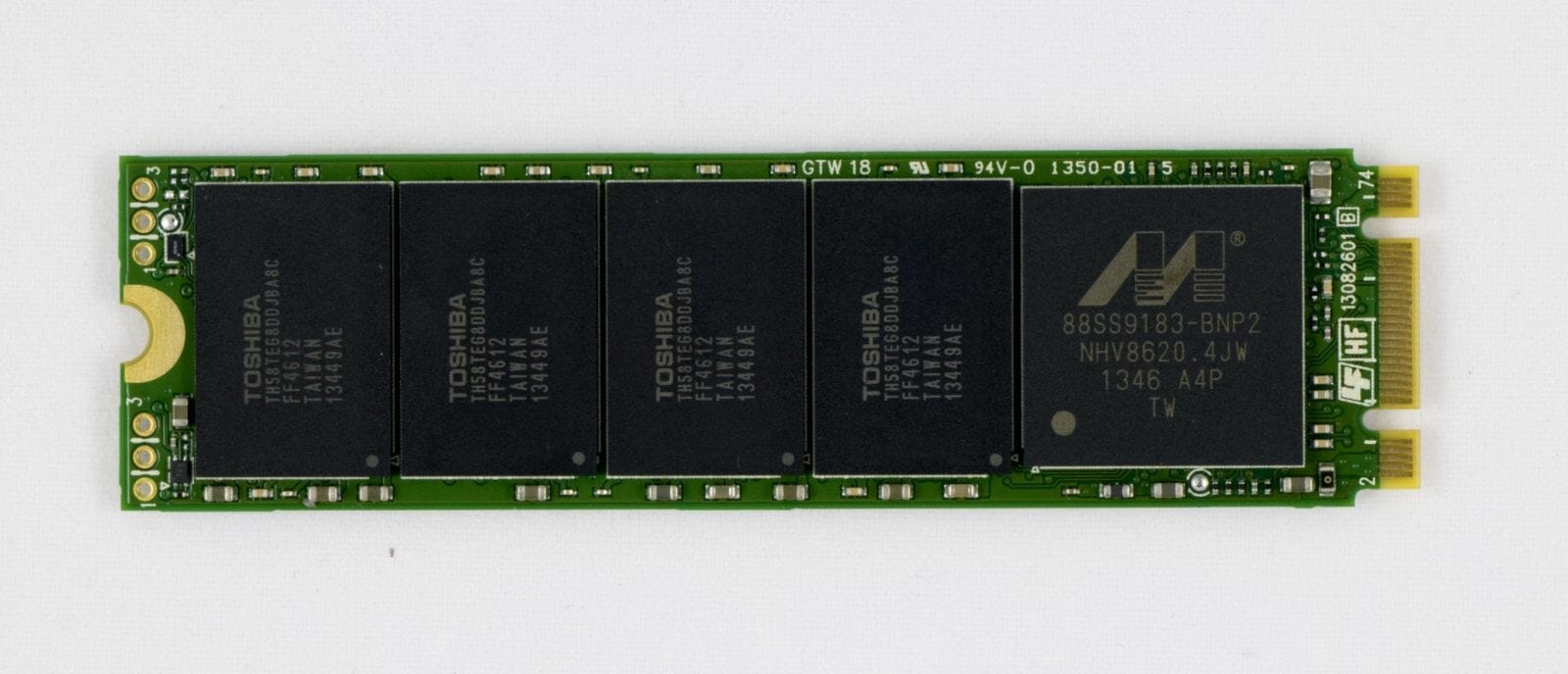
The flash memory is managed by a Marvell 88SS9183-BNP2 controller, which must be the first popular consumer-class SSD controller to support PCI Express. At least it is used in the majority of non-server SSDs with native PCIe support available today. The 8-channel controller uses the most optimal 4-way interleave in the 256GB version of the M6e.
One more chip on board the M6e is a DDR3 SDRAM buffer for caching, wear leveling and garbage collection technologies. The buffer size is 512 MB in our SSD. It is a DDR3-1333 SDRAM chip from Nanya.
As for the PCIe adapter, it is extremely simple, just connecting the PCIe lanes from the mainboard’s slot to its own M.2 connector. It is this connector that the M.2 SSD card is plugged in. The adapter is universal, by the way. It is not designed specifically for the M6e.
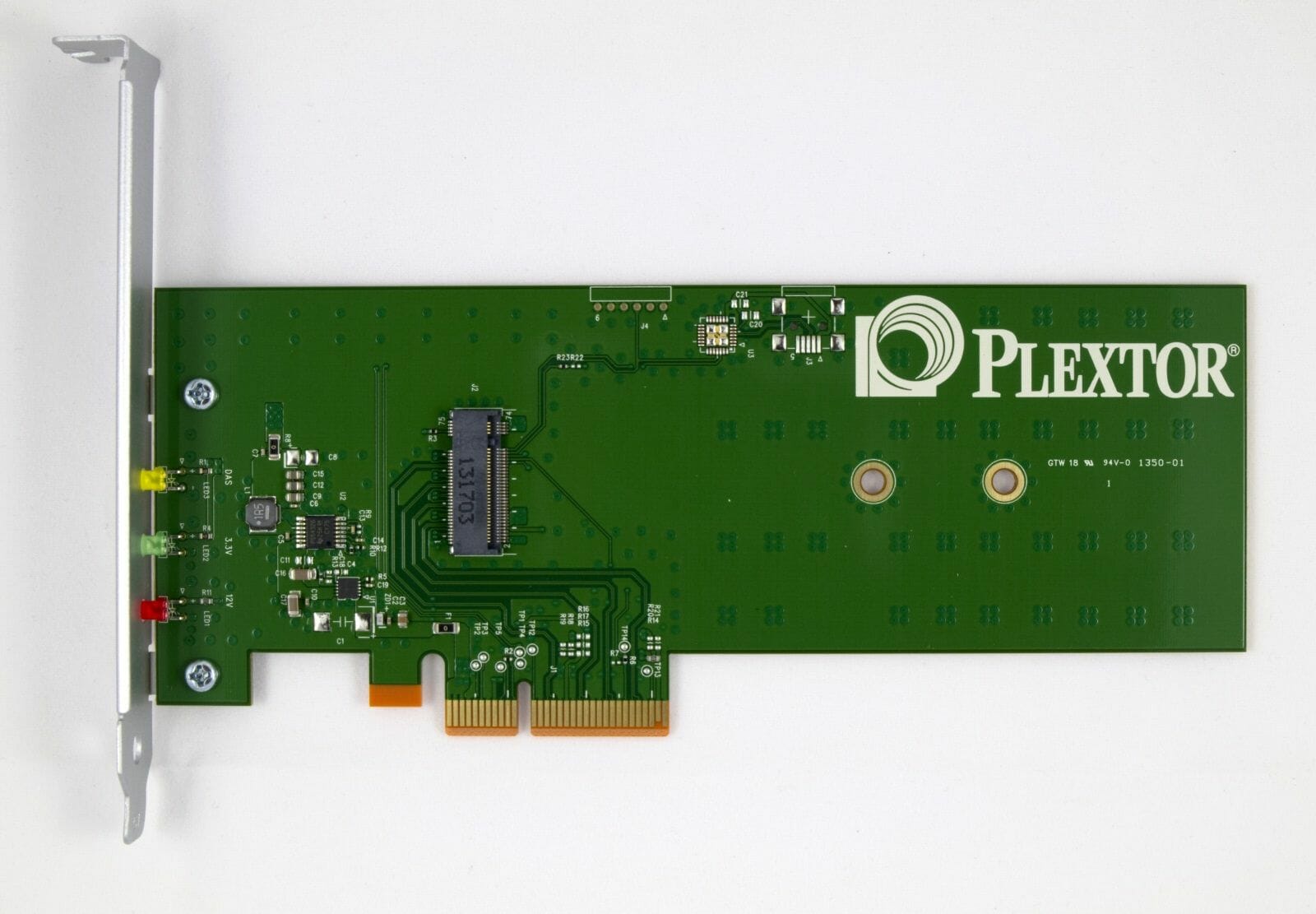
The adapter connects four PCIe lanes to the M.2 slot but the M6e SSD uses only two of them. There are three LEDs: the red and green ones indicate power whereas the yellow one is indicative of ongoing data transfers. The mainboard’s standard disk activity indicator doesn’t work with the M6e, so you can only monitor disk access by that yellow LED.
The specifications of the Plextor M6e 256GB are summed up below:
- Controller: Marvell 88SS9183
- Interface: PCI Express 2.0 x2
- Form-factor: PCIe x4 HHHL expansion card or M.2 2280
- Flash memory: Toshiba’s synchronous 64-gigabit 19nm MLC NAND flash memory with Toggle Mode interface
- Capacity: 256 gigabytes / 238 gibibytes
- Cache memory: 512MB DDR3-1333 SDRAM
- Sequential read speed: 770 MB/s
- Sequential write speed: 580 MB/s
- Random read speed (in 4KB data blocks): 105,000 IOPS
- Random write speed (in 4KB data blocks): 100,000 IOPS
The specified sequential read and write speeds are most impressive. SATA drives can’t provide them because of their lower interface bandwidth. The random speeds are comparable to those of the best SATA 6 Gbit/s products, however. The M6e specs suggest that simply transitioning an SSD to the PCIe 2.0 x2 bus won’t ensure huge performance benefits without new controllers. The Marvell 88SS9183 chip is not the best choice for PCIe SSDs, actually. There are faster platforms even from the same Marvell, such as the 88SS9293, but Plextor doesn’t seem to be willing to set new performance records.
One more odd thing about the specs is the lack of endurance data. The SSD comes with a 5-year warranty but we don’t know how much data can be written to it throughout its lifecycle. It is possible that the M6e uses the same flash memory as the M5 Pro and will be as reliable as the previous flagship model.
Like earlier Plextor products, the M6e supports hardware AES encryption with 256-bit key. It doesn’t support TCG Opal 2.0 and IEEE-1667, though. So it is still impossible to manage your encrypted drive easily from the Windows environment.
Testbed and Methods
We will test our Plextor M6e 256GB using a special testbed with an ASUS Z97-Deluxe mainboard. It is based on the Intel Z97 chipset, so we can test the SSD in three ways:
- Installed into an M.2 slot provided by mainboards with Intel’s 9 series chipsets and connected to a PCI Express 2.0 x2 bus via the chipset.
- Installed into a PCI Express 2.0 x2/x4 slot implemented via the chipset. It must be noted that such slots are not available on all modern mainboards due to lack of PCIe lanes. And even if they are present, they are likely to be based on additional switches. That’s the case with our ASUS Z97-Deluxe mainboard. Although not the most efficient, it is the most popular solution.
- Installed into a PCIe 3.0 x16 slot implemented via the CPU. This is going to be faster because there are no intermediary (chipset or switch) between the SSD and the CPU. But the graphics card is going to work in PCIe 3.0 x8 mode in this case on LGA1150/1155 platforms, which may be unacceptable for enthusiasts.
Since we’re testing a premium-class product today, which is quite expensive for a consumer-class SSD, we’ve selected the fastest SATA models and also built a RAID0 array which, like a PCIe drive, has no artificial limitations in terms of peak interface bandwidth.
So, besides the Plextor M6e, we will benchmark a Samsung 840 Pro (based on a Samsung MDX controller and 21nm MLC NAND flash), a Samsung 840 EVO (Samsung MEX controller and 19nm TLC NAND flash), and a RAID0 array built out of two Samsung 840 EVO drives. The tested SSD configurations are comparable to the M6e in storage capacity: 240/250/256 GB.
The hardware components we will use in this test session are listed below:
- Processor: Intel Core i5-4690 (Haswell, 4 cores, 3.5-3.9 GHz, 4x256KB L2, 6MB L3)
- CPU cooler: Noctua NH-U14S
- Mainboard: ASUS Z97-Deluxe (LGA1150, Intel Z97)
- System memory: 2x8GB G.Skill [TridentX] F3-2133C9D-16GTX DDR3-2133 SDRAM (9-11-11-31)
- Graphics card: Nvidia GeForce GTX 780 Ti (3 GB/384-bit GDDR5, 876-928/7000 MHz)
- System disk: Crucial m4 256GB (CT256M4SSD2)
- Tested SSDs:
- Plextor M6e 256GB (PX-AG256M6e, firmware 1.02)
- Samsung 840 Pro 256GB (MZ-7PD256, firmware DXM06B0Q)
- Samsung 840 EVO 250GB (MZ-7TE250, firmware EXT0BB6Q)
- RAID0 array built out of two Samsung 840 EVO 120GB (MZ-7TE120, firmware EXT0BB6Q)
- Power supply: Corsair AX760i (80 Plus Platinum, 760 W)
- Intel Chipset Driver 10.0.13
- Intel Management Engine Driver 10.0.0.1204
- Intel Rapid Storage Technology 13.0.3.1001
- NVIDIA GeForce Driver 335.23
We carry out our tests in Microsoft Windows 7 SP1 Ultimate x64 with the following drivers:
Performance
Sequential/Random Read and Write
We use Anvil’s Storage Utilities 1.1.0.337 to measure random and sequential read and write speeds of our SSDs. The synthetic benchmark integrated into this software suite provides a great overview of the tested products by checking out their key speed characteristics. The results you will see here refer to the FOB performance (fresh out-of-box, i.e. non-degraded) of the SSDs. It must also be noted that we use incompressible data for this test.
The Plextor M6e performs differently depending on its connection type. The chipset- and CPU-based PCIe buses are comparable in terms of sequential reading and writing. The data access latency varies, however, between the connection types, affecting the speed of random-address reading and writing. So, the Plextor M6e delivers its best performance when installed in a PCIe 3.0 x16 slot designed for graphics cards and directly connected to the CPU. If the SSD is plugged into a chipset-based PCIe slot, its performance is lower, by up to 50% in the worst case (writing of random-address 4KB data blocks). It must be noted that the M.2 slot turns out to be even worse than the PCIe x2 slot, probably due to the additional multiplexer which translates PCIe lanes into SATA ports inside Intel’s chipset.
Anyway, the Plextor M6e is faster than its SATA opponents at sequential operations, especially at sequential reading where it is more than 30% ahead of the fastest SATA drive Samsung 840 Pro. On the other hand, it is unable to match the sequential speed of the RAID0 array due to the bandwidth limitations of the two PCIe 2.0 lanes implemented in the Marvell controller.
When it comes to random-address operations, the Plextor M6e is no better than the SATA flagship Samsung 840 Pro. It falls behind the best SATA 6 Gbit/s drive even if installed into a PCIe 3.0 x16 slot, which is an indication of insufficiently high performance of the Marvell 88SS9183 controller.
So, the PCI Express bus helps improve the speed of sequential operations but PCIe SSDs may turn out to be slower than SATA-based models in real-life applications, at least until there appear new controllers with higher performance. As for today, even if you are interested in high sequential reading and writing, a simple RAID0 array built out of SATA-based SSDs will be preferable to a single PCIe 2.0 x2 SSD. In other words, the Plextor M6e doesn’t offer any indisputable advantages at the moment.
Performance Degradation, Garbage Collection and TRIM
One peculiarity about SSDs is that their performance is not constant but varies depending on multiple factors. First of all, it is important whether their flash memory is clean or filled with data. Then, various caching techniques, which are now implemented by many SSD makers, may influence the speed of writing. That’s why we check out how SSDs change their performance while processing a continuous stream of random-address write requests. Such tests can reveal a lot of interesting information about an SSD’s internal operation algorithms.
So in the first test we make the SSD process a continuous stream of requests to write random-address 4KB data blocks with a request queue depth of 32. The diagram below shows the correlation between instantaneous performance and the amount of written data. The test is carried out over a 2-hour period, so we can see what performance is delivered by the SSD in its out-of-box state, in its steady state and in all the in-between states. It is important to note that the test is continuous, so we don’t let the SSD use its garbage collection algorithms which are evoked in idle mode.
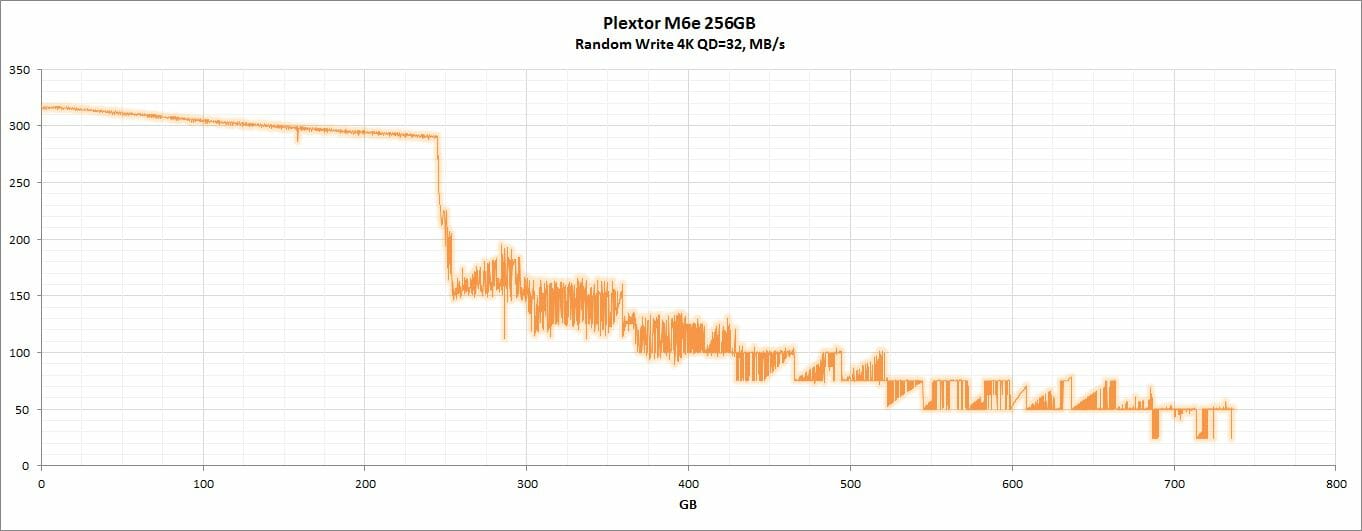
The Plextor M6e 256GB doesn’t show any surprises here. Its performance changes depending on the amount of continuously written data in the same way as with any other modern SSD. In its out-of-box state, it writes at a nearly constant and high speed. Then, after writing about 240 GB, its performance drops down. This performance hit occurs when the controller runs out of free memory pages and has to restore them prior to reusing. The write speed graph goes steadily down to about 50 MB/s as the consequence. That’s the write speed the Plextor M6e would eventually have if it didn’t support the TRIM command and garbage collection technique.
You shouldn’t worry about that performance hit, actually. Every SSD has technologies to keep its performance high. When idle, modern SSDs rearrange data in flash memory blocks so as to achieve maximum write performance. We carry out a special test to check this out. After the 2-hour continuous writing which leads to performance degradation we disable TRIM and wait for 15 minutes. During this time the SSD should try to recover through garbage collection – and without any help on the OS’s part. Then we enable TRIM in the OS, have another 15-minute pause and benchmark performance once again to see how well the SSD processes the TRIM command.
The TRIM command is executed by the Plextor M6e as required, fully restoring its performance back to the original level. Users of this drive will not have any performance degradation in a TRIM-supporting environment, i.e. while running ordinary applications in popular OSes.
As for TRIM-less background garbage collection, there are some peculiarities. Plextor’s older SSDs had the ability to restore their writing performance without TRIM. The M6e has this ability too, but in a limited version. First, its garbage collection restores its speed not to its out-of-box level but slightly lower. And second, the drive only restores about 9.5 GB for further operations. It means the SSD will only be able to write 9.5 GB at full speed after garbage collection and then will slow down again until the next idle period. That’s not an impressive result considering that the 256GB version of the Plextor M6e has over 17 gigabytes of storage space reserved for such purposes.
Futuremark PCMark 8
Futuremark PCMark 8 contains a special disk subsystem benchmark. It is not a synthetic test but is based on real-life applications. This benchmark reproduces typical disk usage scenarios and measures how fast they are performed. Compared to PCMark 7, it features more scenarios based on Adobe and Microsoft applications as well as games. The result is calculated as the average speed across all of the subtests.
We run PCMark 8 on steady-state SSDs, just as they are going to be used in actual computers. Their performance in this case is affected not only by their controller or flash memory speed but also by the efficiency of their internal algorithms that fight performance degradation.
As opposed to the synthetic benchmarks, PCMark 8 simulates real-life loads by reproducing prerecorded disk activity traces. This test is indicative of what impression the user will get from a particular SSD in practice. And it looks like Plextor’s new PCIe SSD isn’t much different from regular SATA 6 Gbit/s products in real-life applications. The M6e is only better than the Samsung 840 Pro when connected to the CPU-based PCIe slot. If connected via the chipset-based PCIe slot, it can’t compete for the leading position. The overall PCMark 8 winner is the RAID0 configuration built out of two inexpensive Samsung 840 EVO drives.
The overall PCMark 8 results are the average of the individual subtests, so let’s check the latter out, too.
The use of PCI Express x2 instead of SATA 6 Gbit/s is only beneficial in one case: at sequential reading or writing. That’s why there are not so many scenarios where the Plextor M6e can beat the fastest SATA drive Samsung 840 Pro. These are but three applications: After Effects, Photoshop and Word. In the rest of the cases the new product from Plextor doesn’t provide any performance benefits.
Intel NAS Performance Toolkit
Intel NASPT is another disk sub-system test that employs real-life usage scenarios. Like PCMark 8, Intel NASPT reproduces predefined disk activity traces and measures how fast they are executed. However, the default traces are designed for network attached storage devices rather than for SSDs. Therefore during our test session we replace them with the specially developed SSD Benchmarking Suite which offers more relevant usage scenarios such as compressing and decompressing files, compiling large projects, copying files and folders, loading 3D game levels, installing software, batch-processing photos, searching a digital library for data, mass-launching applications, and transcoding video.
Like PCMark 8, this benchmark gives us a true-to-life illustration of disk subsystem performance. Here the SSDs are again tested in their “steady” state.
Intel NASPT agrees with PCMark 8 in its evaluation of the Plextor M6e. Plextor’s PCIe drive delivers higher performance than the flagship SATA-based products in one case only: when installed into a fast PCIe slot directly connected to the CPU. Such slots are actually meant for graphics cards. And if you connect your Plextor M6e to the chipset using any kind of slot or port, it will be inferior to the Samsung 840 Pro in speed.
Besides the average benchmark score, we would also like to offer you the results of individual usage scenarios, which explain the overall results of the Plextor M6e. Take note that the data-transfer rate is higher than the interface bandwidth in some subtests. That’s because INASPT is a high-level benchmark that uses standard Windows functions to access the disk subsystem. The OS’s caching mechanisms come into play then.
Alas, there are not so many applications where Plextor’s PCIe drive is really faster than its SATA opponents. There are scenarios where the M6e is inferior to the affordable Samsung 840 EVO even. It means the M6e is actually a low-performance solution that uses a fast interface. Every time this drive has to process random-address operations, it falls behind premium solutions with the slower SATA 6 Gbit/s interface.
File Copy Speed
We use AS SSD version 1.7.4739.38088 to benchmark the speed of copying different types of files within a single partition the size of the whole SSD. The SSDs are tested in their steady state again.
Copying files within the same SSD is a specific load that requires parallel processing of both read and write requests. The Plextor M6e is good in this test, largely due to its high interface bandwidth. The RAID array does even better, though. So if you feel your disk subsystem lacks bandwidth, you may want to prefer a RAID0 built out of ordinary SATA SSDs to the Plextor M6e.
Conclusion
Although Plextor promotes its M6e PCIe drive as a flagship and innovative solution, we’ve formed a different opinion about it. Yes, the PCI Express bus is good. It has more bandwidth than SATA. But for an SSD to be regarded as a high-performance solution, it must be good at processing random-address requests. And that’s the weak spot of the M6e. Its Marvell 88SS9183 controller has rather low computing performance, so the M6e turns out to be slower than flagship SATA 6 Gbit/s products at random-address reading and writing.
The M6e’s using PCIe 2.0 x2 is questionable, too. Yes, this bus has about 40% more bandwidth than SATA 6 Gbit/s, but we’d like to have even more from a flagship SSD designed as a PCIe card. Plextor might have used four PCIe lanes to improve the speed of sequential reading and writing further but the manufacturer’s desire to unify the design of the M6e with the same drive in M.2 form-factor poses problems that might have been avoided. These problems are exacerbated by the PCIe implementation in Intel’s 9 series chipsets which introduces additional latencies.
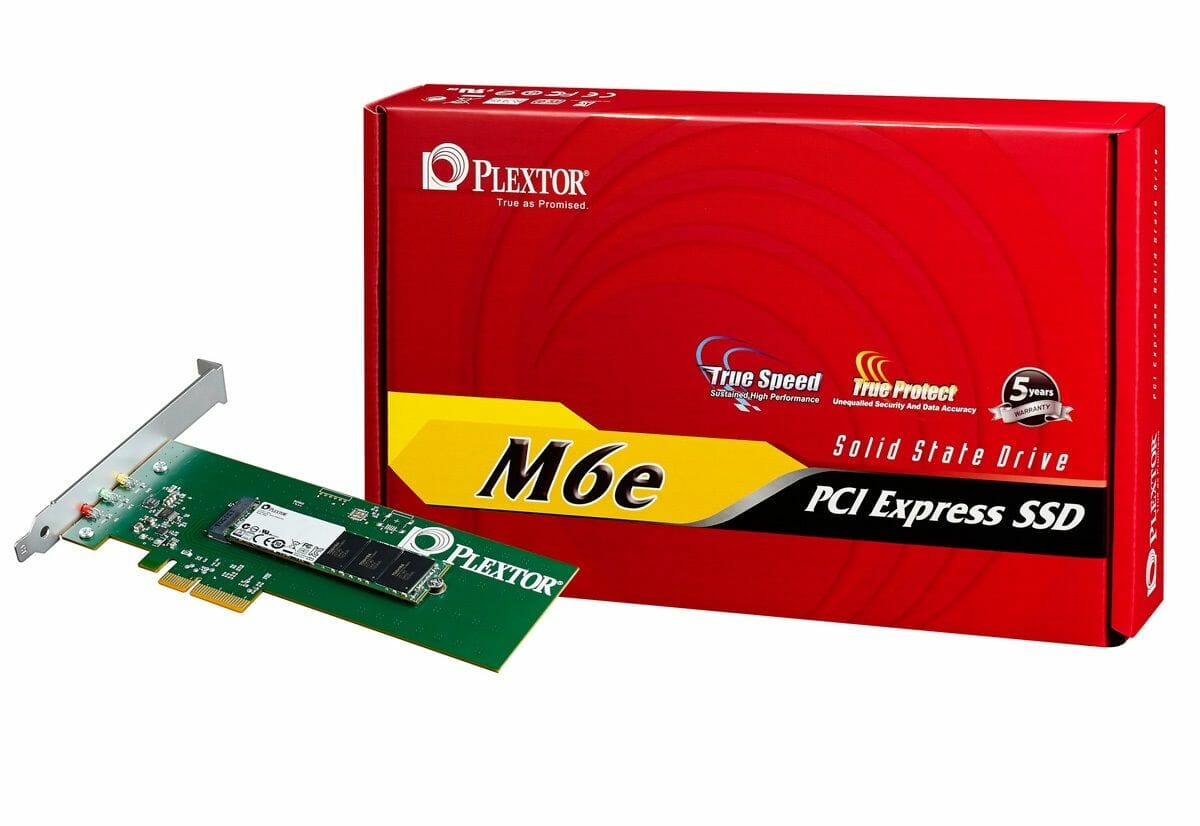
Summing it up, the Plextor M6e is not a high-speed premium-class desktop SSD as expected but a rather mediocre mobile new-generation M.2 drive adapted for desktop PCs. It may be more or less interesting until Plextor’s competitors use the same trick. And it will lose its originality as soon as there appear a lot of M.2 drives and PCIe->M.2 adapters. We expect this to happen in the nearest future.
So, despite all the hype about the Plextor M6e, our favorite as the best SSD for desktop PCs is still Samsung’s 840 Pro. The latter is faster at processing random-address requests, which are a large part of real-life loads, and costs less. And if you want high speed of sequential operations, you can get better performance than the M6e’s by building a RAID0 array out of regular SATA-based SSDs.